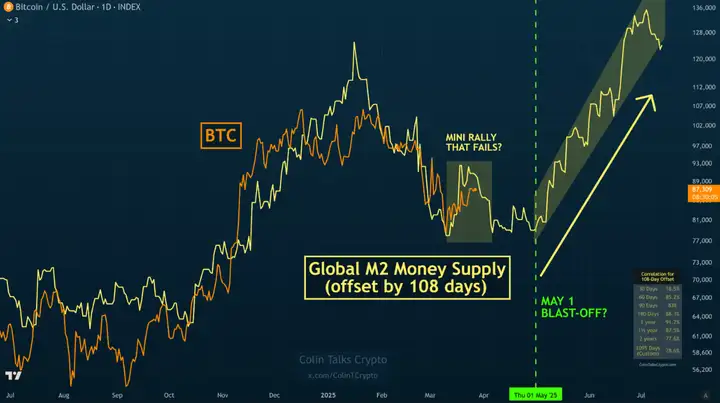Bitcoin showed a positive performance at the beginning of the week, but quickly reversed its trend, returning to a downward trajectory. On March 28, BTC dropped 3.5%, with an intraday low of $83,585. This price rejection occurred precisely at the intersection of the descending trend line (black) and the upper boundary of the ascending channel.
VX: TZ7971

On the daily chart, BTC has once again fallen below the 200-day Exponential Moving Average (EMA). If it closes below this critical level, selling pressure may increase, potentially driving further price pullback.
Global Liquidity Expansion Needed to Support Bitcoin Price
If liquidity conditions do not change, Bitcoin might retrace to the $75,000 area.
Macro liquidity refers to the total available capital in the financial system that can easily flow into risk assets like stocks and cryptocurrencies. However, this factor is influenced by interest rates, Federal Reserve (Fed) policies, and market conditions.
According to capital flow indicators, Bitcoin shows a "stronger convergence" with traditional risk assets but remains on the edge of the risk curve. This means that for capital to return to BTC, investor sentiment needs to shift from low-risk assets like bonds to higher-risk assets such as BTC or low-quality bank stocks in the Russell Index.
The current macro liquidity environment is neutral. Interest rates have slightly decreased, but arbitrage trading continues to pose risks to assets.
An increase in global M2 money supply could trigger a BTC price rise. The global liquidity chart tracking major central banks' M2 growth previously showed a correlation with Bitcoin price trends.

The correlation between M2 supply and BTC suggests a price increase around May 1st, which could persist for two months.
However, a key distinction between macro liquidity and global M2 growth is that M2 measures total money supply, while macro liquidity reflects the ease of capital flowing into risk assets. It's important to note that even if M2 money supply increases, macro liquidity can remain unchanged if these funds are allocated to lower-risk assets.
The volume of funds within the system is no longer increasing as it did in the past.
Bitcoin Fills CME Gap Below $85,000
Bitcoin's recent surge led to a gap on CME between $84,435 and $85,000. CME gaps are the difference between the CME Bitcoin futures contract's Friday closing price and Sunday night's opening price. These gaps are typically filled over time, with traders viewing these levels as support or resistance based on market structure.

As shown, BTC price filled the CME gap before closing on March 28, which could lead to a short-term rebound. The CME gap also coincides with BTC price retesting the lower limit of the ongoing ascending channel pattern.
A new bottom for 2025 is at $75,000.
Entering the second quarter of 2025, the global crypto market faces a complex intersection of macroeconomic and geopolitical pressures.
Driven by macroeconomic factors like potential Fed rate cuts, Bitcoin could potentially break through $90,000.
February's CPI data being lower than expected increases the likelihood of rate cuts. If rate cuts are successful, a liquidity surge could reignite bullish momentum, pushing stocks and Bitcoin past key resistance levels.
With increasingly clear regulations and strategic crypto reserves, Bitcoin's price could reach $150,000 to $200,000 by the end of the year.
Currently troubled by tariff issues, Bitcoin's price will continue to fluctuate in the $75,000 to $85,000 range.
The moment tariffs are lifted could provide a massive boost to stocks and cryptocurrencies, potentially paving the way for Bitcoin's next big move.
These market adjustments present a good entry opportunity. For those seeking stability, Bitcoin might be the best choice.







